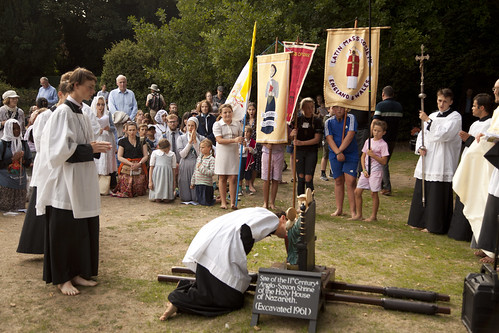 |
| Mass at the St Catherine's Trust Summer School in 2022 |
Cross posted from LMS Chairman blog.
There is an interesting article in the Una Voce Scotland Newsletter, from April 2022, by a young mother who took part in the Synod on Synodality discussions in her parish. The article in anonymous. She describes how she explained to the meeting she attended that her own experiences of the Novus Ordo 'children's liturgy' and catechesis had been underwhelming, and that most of her contemporaries had lapsed. She, however, had discovered the Traditional Mass, and her small son was so taken by the bells and smells that he was copying the bell and the thurible in his play.
He takes a rattle in his hands and pretends that he’s ringing the Sanctus bells (kneeling down and saying “ring, ring”) and swings his hands in front of him in the act of censing (“chk, chk!”). Where I was hardly aware of – and even distracted from – what was taking place in front of me during (Novus Ordo] Children’s Mass, my infant son is inspired by the traditional liturgy, his imagination fueled with enough images, sounds, smells and actions to take him through the week.My conversation partners, formerly quite talkative, received this account with a stony silence and shifting brows – some rose, some furrowed. The pause was broken by Shona, who wanted to add another problem to our list: “You know, we had a priest in our parish who caused a few people to leave. He wouldn’t accept any change, you see, and didn’t connect well with the people, especially not with the children. He was very set in his ways.” And that was that.
I have been researching bishops' conferences submissions to the Synod insofar as they refer to the Traditional Mass. Many don't, but in Scotland and in England and Wales the bishops, to be fair to them, acknowledge the issue with a degree of openness, if not explicit sympathy. Nevertheless I think that Shona's response is very telling, and that she could stand for many, not just laity and not just in Scotland. And for that matter the experiences of the author of the article are also typical of a lot of people who attend the Traditional Mass today.
I myself remember the toe-curling liturgies which were intended to engage me and my contemporaries as teenagers. I suppose they would mostly have lapsed anyway, but these Masses did nothing to help. This has been going on for half a century, plenty of time, I would have thought, for the lesson to be learned, but it seems some people are completely closed to reality. When you mention to them that, by contrast, the Traditional Mass works really well for children, they can't deal with it at all. It is too far removed from their cherished assumptions for them to be able to process the information.
The fact is that it was never an empirical question for them; whether or not they would articulate it this way to themselves, it is fundamentally a theological question. The evocation of transcendent holiness in the Traditional Mass, which makes such a strong impression even on small children, and motivates young men and women to consider vocations and take marriage seriously, is for them wrong theologically. It if works pastorally, this is an embarrassing fact which needs to be denied until it goes away: perhaps it will go away, if the Traditional Mass is banned.
On the other hand, the emphasis on a largely fake parish community is right theologically, so if it is not working pastorally it just needs to be tried harder.
I say 'largely fake' because although a congregation is a worshiping community in a theological sense, if worship as a supernatural reality is pushed into the background and a natural conception of community is emphasised, there is very little if any natural community to work with. Members of a congregation are overwhelmingly not people who work together or spend leisure time together in the week. Modern Catholic parishes simply don't operate like 18th century village churches.
Shona's way of dealing with all this is to reach for the stereotypical 'bad rigid priest' who puts people off coming to church because he is 'very set in his ways'. Talk of the Traditional Mass naturally brings to mind the problem of people being 'very set in their ways' because the old Mass, as she conceives of it, is something from the past that its supporters are morbidly attached to: they can't let it go.
The stereotype is ludicrous because today Traditionalists who are young adults, parents with children, or young priests, are not clinging to something in their own past: we are seeking out and reviving something that was taken away from parishes before we were even born. We are the ones open to new experiences and to empirical facts. Shona and her like are accusing us of what she is herself guilty of: a rigidity about pastoral strategy and liturgy. She won't accept change. She's very set in her ways.
Shona doesn't represent everyone, but there is an important segment of opinion which thinks like her. It is so utterly closed-minded that practically anything is preferable to living in peace with celebrations of the Traditional Mass. Even the mildest efforts to restore sacrality to the Novus Ordo, like the 2011 ICEL version of the Mass or clampdowns on liturgical abuses, are greeted with horror, and even apostacy.
How these views are going to be 'synthesised' with those of everyone else in the Church in the Synod remains to be seen.
 |
| The conclusion of the LMS Walking Pilgrimage to Walsingham 2022 |